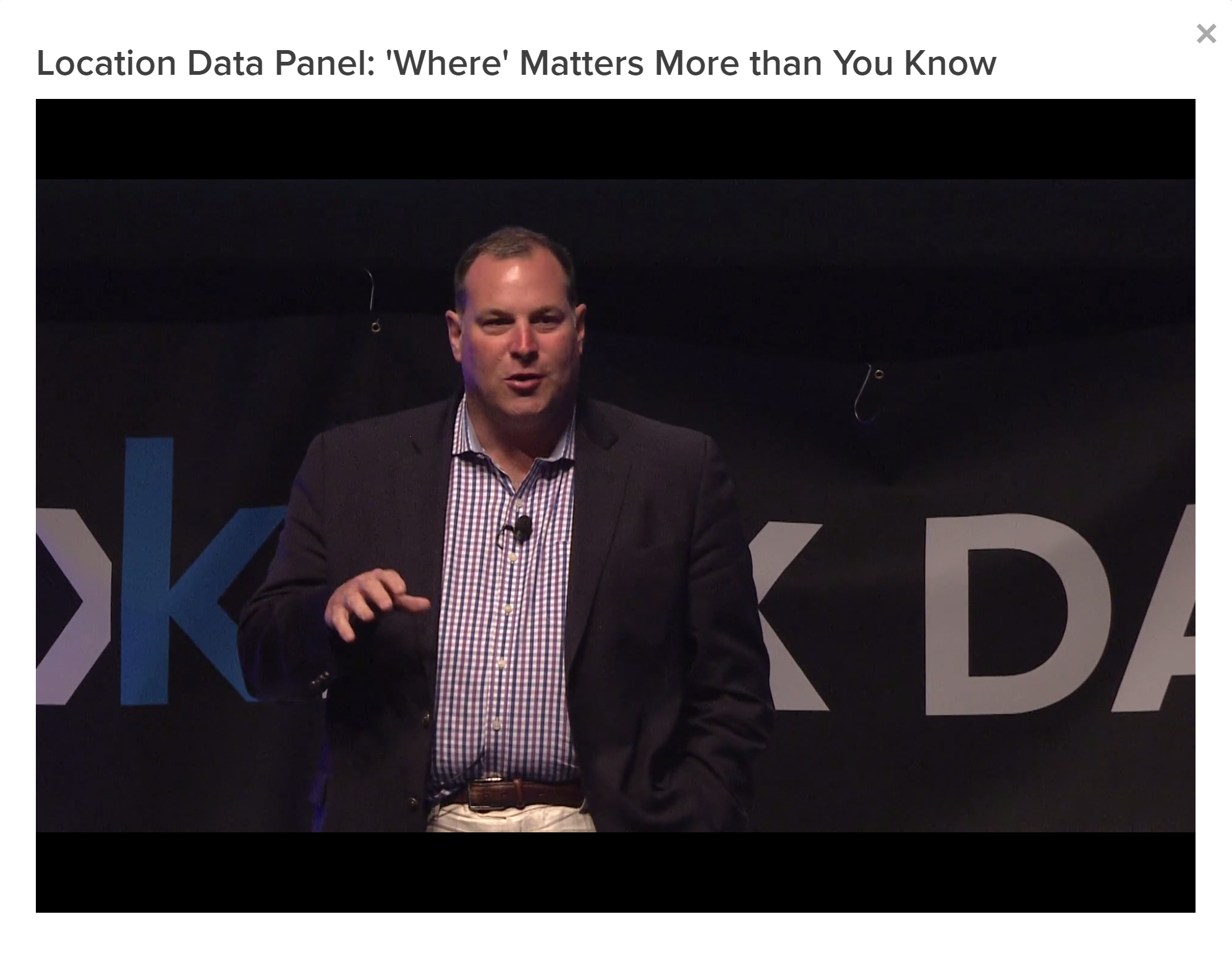
Chris O’Hara ’90 of Salesforce is helping companies ethically navigate the evolving world of digital marketing and consumer data.
BY DOUG DANIELS
There’s an iconic scene in Steven Spielberg’s Minority Report (a sci-fi thriller) in which Tom Cruise walks through a shopping mall, a steady stream of jabbering digital billboards scanning his retinas and instantly plying him with personalized advertisements that call his character out by name and even reference past purchases.
That movie is set in the year 2054. But today, we already have much of the technical capability to create the type of intrusive consumer experience Spielberg’s film envisioned, generating unprecedented opportunities for businesses and organizations to reach their customers, clients and audiences with precision-targeted strategies. This can be a double-edged sword, offering consumers more-personalized marketing and advertising and introducing them to products they love while also presenting a potential slippery slope into privacy violations and misuse of online data.
“The challenge is striking a balance,” says Chris O’Hara ’90, P’24, VP of global product marketing in the Data and Identity Group at Salesforce, a cloud-based software company that provides customer relationship management services. “People really want personalization, but they also want privacy. And now, either because of new state-level laws or because of voluntary company policies, organizations are looking at how to start collecting data from consumers in a more responsible way and still offer that personalization.”
Salesforce, with its headquarters in San Francisco, has grown exponentially since its founding in 1999, with 60,000 employees and more than $21 billion in revenue for the 2021 fiscal year. And as the world’s digital reliance continues to spread, Salesforce and its subsidiaries are expected to see steady revenue growth in the years to come.
Tech giants like Apple and Google are dramatically changing the way they use and share personal data, and many companies are now scrambling to adjust to the new challenges to marketing and advertising as their access to that data becomes increasingly limited.
But while the privacy landscape is certainly changing in the U.S., not everywhere in the world is following suit. While Europe led the way with its highly restrictive General Data Protection Regulation, or GDPR, Japan has taken a different approach. There, billboards have been equipped with facial recognition cameras so they can identify a person’s gender and age as they’re walking past and instantly tailor ads to them, not unlike the scene in Minority Report. The technology is intended to be anonymous, but it isn’t a giant leap to totally personalized advertising, and that raises enormous privacy concerns. Facial recognition technology is becoming so common that many of us unlock our phones with it now. Beyond the business and advertising implications, there are also questions about data obtained by government and law enforcement entities. The FBI alone has access to nearly half a billion images for facial recognition uses.
Traditionally, data from various websites is aggregated and profiles are built based on site visits. Lots of the browsing data on laptops, and desktops are captured via “cookies,” or little snippets of code that identify users and store their data. Mobile phones and other web-connected devices (even some refrigerators) also capture behavioral data. Widely available for purchase on open marketplaces, this consumer data can include credit scores, online behavior, a person’s specific interests, particular websites they’ve visited—all information collected and shared almost entirely without the knowledge of the precise individual. If you have ever looked at a pair of shoes online and then noticed ads for those exact same shoes that follow you to a series of other websites, such as news sites, that is part of what cookies do.
A big development in data regulation came in 2018, when California passed the California Consumer Privacy Act, requiring more transparency and limits relating to data use. That’s when you may have started noticing the ubiquitous pop-ups on websites asking you to opt in or out of a company’s data collection or cookies policy.
Google has said it plans to enforce new policies by next year, depriving marketers of the ability to purchase the type of data they’ve long treasured. Exactly how consumer relationships are built moving forward and how marketers and advertisers ply their online trade will most likely involve a blend of new tactics and strategies that will replace the use of third-party cookies, which have been a central component of online advertising for years.
“One idea is something called FLoC—Federated Learning of Cohorts,” O’Hara explains. “The way that would work is Google will identify somebody as belonging to one or multiple cohorts, which are basically groups based on people’s interests. So you might be in the fashionista cohort, or the traveler cohort, or the outdoors-enthusiast cohort, and you’ll be assigned this random number and Google will build these various FLoCs as long as there are enough people who meet the criteria.”
This type of group-level web tracking would represent a significant shift for how advertisers identify new potential customers. Instead of companies targeting the browsing history and hyperspecific consumer data about individuals, they’ll now be forced to settle for information about various cohorts as a whole.
What will these new privacy rules mean for big publishers and big marketers, and how will they collect and use data responsibly?
Say, for example, you are identified as a European-travel intender and antique-thimble collector. Instead of having your personal information shared, you would simply be assigned anonymously to a larger group that could include thousands or millions of antique thimble collectors. No individual-level data that could violate privacy would be included.
“The advertising industry is pushing back on this idea of cohorts, because obviously they’re used to doing things a certain way, and it has sparked a really big, raging debate about what the future is going to look like and how it’s going to work,” O’Hara says.
“What will these new privacy rules mean for big publishers and big marketers, and how will they collect and use data responsibly? Advertisers need to learn to use Google, Facebook and Amazon in new, effective ways that are still responsible and ethical.”
One important ongoing debate, O’Hara says, revolves around whether companies such as Facebook, Twitter and Google are objective “platforms” for content or they should be considered “publishers,” since they do exercise some editorial control and create their own algorithms and other structural elements that can control who sees what information.
O’Hara has been working in data-driven marketing and advertising from the earliest days, when the concept seemed more science fiction than concrete business necessity. An English major at Conn, his passions resided in creative writing, philosophy and drama. But a post-college job as a writer and editor for a cigar magazine introduced him to emerging marketing and advertising strategies just when the internet was beginning to broaden its reach, in the 1990s.
He quickly discovered he had a knack for sales and advertising and began learning about data-driven tools that would later prove revolutionary. He joined Salesforce four years ago, when it acquired Krux, the startup where O’Hara led data strategy, for $800 million. Krux, a data management firm, helped clients in the marketing industry better understand, analyze and target the customers who visited their websites and apps so that they could improve engagement and enhance customer relations through the use of far more precise ad targeting.
He and the co-founders of Krux wrote Data Driven, a book that examines the ways in which new data is transforming marketing. His latest book is titled Customer Data Platforms: Use People Data to Transform the Future of Marketing Engagement. The extensive line of marketing products Salesforce offers includes software for marketing emails, mobile ad campaigns, social media advertising and analytics, making it a one-stop shop for digital marketing. O’Hara’s role involves marketing and strategy for the products related to data.
“My job is to meet with clients and discuss data strategy with them and determine how to better understand people through their data,” he says. “This way, I can help them build better experiences across different touchpoints for their customers.”
A big part of what O’Hara does for clients at Salesforce is coordinate customer data in ways that improve customer service and incorporate more efficiency. For example, few people have been spared the misery of speaking to a call center representative who has a boilerplate script yet no knowledge of your history with the company or how to resolve your individual issue. Large companies often have disparate databases where customer info is stored. Salesforce helps consolidate data and use it more effectively so that when somebody contacts a call center, the person on the other end of the phone instantly has access to the caller’s order history, their interests and the marketing campaigns they’ve already been exposed to. The customer doesn’t have to start from scratch with each new person they speak to, repeatedly providing order numbers and other details.
“It may sound simple, but that’s really what creates value,” O’Hara says. “That’s what makes people more likely to stay as a customer, and more likely to spend more money, and it makes them happier and more satisfied. And that’s really, from a broad perspective, the type of stuff we’re working on.”
O’Hara contends that the Covid-19 pandemic has accelerated and forced changes in data collection. While some companies may have been reluctant to embrace a “digital first” model, the pandemic has left them with little choice. The challenge remains to find balance when it comes to privacy and managing data. Prior to Covid, people at least had some control over their marketing experience, in the sense that they could choose to log on to Facebook or Instagram, or to use a phone app to make purchases. But during the pandemic, to help ensure social distancing, many daily tasks—like getting coffee—have transitioned into the digital-first approach O’Hara mentions.
“I love that I can choose to place a coffee order with Dunkin’ Donuts through their iPhone app, go pick it up at the drive-through, and not have to exchange any money to get my order,” O’Hara says.
“But that’s my choice, and I know [Dunkin’ will] be using that data to suggest new items for me to try, for example. Where things cross the line is if I’m just walking by a Dunkin’ Donuts, having never opted in to anything, and my mobile phone lights up within 50 feet and says, ‘Hey, Chris, take 20 percent off a large coffee and a donut.’
“That’s an invasion of privacy, and at that point, you’re just like Tom Cruise walking through that mall.”
{This originally appeared in Connecticut College’s CC Magazine, Summer 2021 issue)


 According to Blue Kai, I’m a tech-savvy, social media-using bookworm in the New York DMA, currently in the market for “entertainment.” At least that’s what my cookie says about me. Simply by going to the Blue Kai data exchange’s
According to Blue Kai, I’m a tech-savvy, social media-using bookworm in the New York DMA, currently in the market for “entertainment.” At least that’s what my cookie says about me. Simply by going to the Blue Kai data exchange’s 









